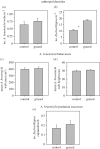Ecosystem engineering strengthens bottom-up and weakens top-down effects via trait-mediated indirect interactions
- PMID: 28931733
- PMCID: PMC5627195
- DOI: 10.1098/rspb.2017.0894
Ecosystem engineering strengthens bottom-up and weakens top-down effects via trait-mediated indirect interactions
Abstract
Trophic interactions and ecosystem engineering are ubiquitous and powerful forces structuring ecosystems, yet how these processes interact to shape natural systems is poorly understood. Moreover, trophic effects can be driven by both density- and trait-mediated interactions. Microcosm studies demonstrate that trait-mediated interactions may be as strong as density-mediated interactions, but the relative importance of these pathways at natural spatial and temporal scales is underexplored. Here, we integrate large-scale field experiments and microcosms to examine the effects of ecosystem engineering on trophic interactions while also exploring how ecological scale influences density- and trait-mediated interaction pathways. We demonstrate that (i) ecosystem engineering can shift the balance between top-down and bottom-up interactions, (ii) such effects can be driven by cryptic trait-mediated interactions, and (iii) the relative importance of density- versus trait-mediated interaction pathways can be scale dependent. Our findings reveal the complex interplay between ecosystem engineering, trophic interactions, and ecological scale in structuring natural systems.
Keywords: bottom-up effects; density-mediated indirect effects; ecosystem engineering; top-down effects; trait-mediated indirect effects.
© 2017 The Authors.
Conflict of interest statement
We declare we have no competing interests.
Figures




References
MeSH terms
LinkOut - more resources
Full Text Sources
Other Literature Sources

